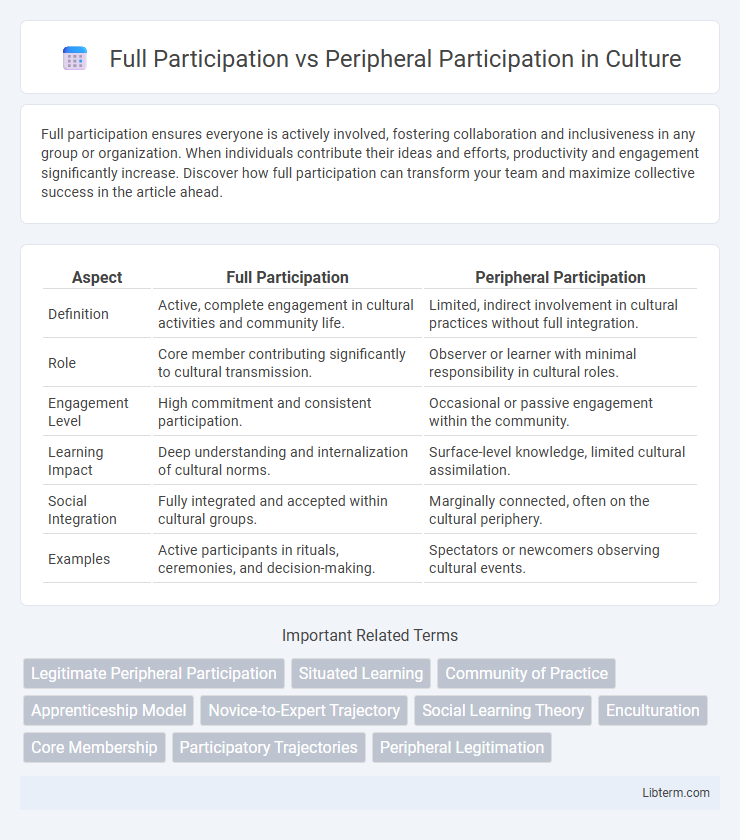Full participation ensures everyone is actively involved, fostering collaboration and inclusiveness in any group or organization. When individuals contribute their ideas and efforts, productivity and engagement significantly increase. Discover how full participation can transform your team and maximize collective success in the article ahead.
Table of Comparison
| Aspect | Full Participation | Peripheral Participation |
|---|---|---|
| Definition | Active, complete engagement in cultural activities and community life. | Limited, indirect involvement in cultural practices without full integration. |
| Role | Core member contributing significantly to cultural transmission. | Observer or learner with minimal responsibility in cultural roles. |
| Engagement Level | High commitment and consistent participation. | Occasional or passive engagement within the community. |
| Learning Impact | Deep understanding and internalization of cultural norms. | Surface-level knowledge, limited cultural assimilation. |
| Social Integration | Fully integrated and accepted within cultural groups. | Marginally connected, often on the cultural periphery. |
| Examples | Active participants in rituals, ceremonies, and decision-making. | Spectators or newcomers observing cultural events. |
Understanding Participation: Full vs. Peripheral
Full participation involves active and consistent engagement in all aspects of an activity or community, fostering deeper learning and integration. Peripheral participation refers to the role of observers or newcomers who engage superficially, gaining understanding gradually without full involvement. Recognizing the distinction between full and peripheral participation helps optimize strategies for inclusive learning and community development.
Defining Full Participation
Full participation entails active involvement and equal contribution within a community or organization, ensuring individuals have meaningful opportunities to influence decisions and access resources. It emphasizes inclusion by removing barriers related to social, economic, or cultural factors to foster equitable engagement. Defining full participation involves recognizing and addressing systemic obstacles that limit marginalized groups from fully exercising their rights and responsibilities.
What is Peripheral Participation?
Peripheral participation refers to the process where individuals engage in a community or activity at a marginal level, gradually gaining exposure and understanding without full involvement. This concept is essential in legitimate peripheral participation theory, where newcomers learn through observation and limited tasks before becoming full participants. Such engagement fosters skill acquisition and social integration while minimizing initial pressure and responsibility.
Key Differences Between Full and Peripheral Participation
Full participation involves active engagement and significant contribution within a group or community, ensuring members have access to all relevant information and decision-making processes. Peripheral participation, by contrast, refers to limited or observational involvement where individuals engage with fewer responsibilities and restricted access to core activities and knowledge. Key differences include the level of influence, access to resources, and the degree of social integration within the group dynamic.
Benefits of Full Participation
Full participation in a learning or work community fosters deeper engagement, enhanced skill development, and stronger social connections compared to peripheral participation. Individuals who fully participate gain comprehensive access to resources, mentorship opportunities, and feedback that accelerate mastery and professional growth. This active involvement also builds a sense of belonging and commitment, which are crucial for motivation and long-term success.
Advantages and Limitations of Peripheral Participation
Peripheral participation allows learners to observe and gradually engage in community practices without immediate full responsibility, providing a low-pressure environment for skill acquisition and social integration. However, its limitations include slower mastery of complex tasks due to limited active involvement and potential feelings of isolation or marginalization from core group activities. This approach is beneficial for novices but may impede rapid expertise development compared to full participation.
Factors Influencing Participation Levels
Factors influencing participation levels in full participation versus peripheral participation include individual motivation, social integration, and access to resources. Full participation often requires a higher degree of confidence, skill acquisition, and support from community members, while peripheral participation may result from limited knowledge, lower engagement, or external barriers. Environmental factors such as organizational culture and communication channels also significantly impact the extent of involvement in collaborative settings.
Real-World Examples of Participation Types
Full participation involves active engagement and contribution within a community or organization, as seen in open-source projects where core developers collaborate to create and maintain software. Peripheral participation occurs when individuals engage in a more observational or limited capacity, like community members who follow discussions and learn from forums without directly contributing. Real-world examples include apprenticeships, where learners observe before gradually increasing involvement (peripheral) versus full-time employees fully integrated into company workflows (full participation).
Impact on Learning and Community Development
Full participation in learning communities fosters deeper knowledge acquisition and stronger social bonds, enhancing both individual competence and collective growth. Peripheral participation allows newcomers to observe and gradually engage, supporting incremental learning and easing integration into the community's culture. This dynamic balance promotes sustained community development by accommodating diverse engagement levels while encouraging progression toward active involvement.
Strategies to Foster Full Participation
Strategies to foster full participation emphasize creating inclusive environments that actively engage all members by providing equitable access to resources, clear communication channels, and opportunities for meaningful contribution. Implementing collaborative tools, encouraging diverse viewpoints, and offering targeted support or training enhance engagement and mitigate barriers faced by peripheral participants. Regular feedback mechanisms and recognition of individual contributions further promote sustained involvement and a sense of belonging within the community or organization.
Full Participation Infographic

 libterm.com
libterm.com